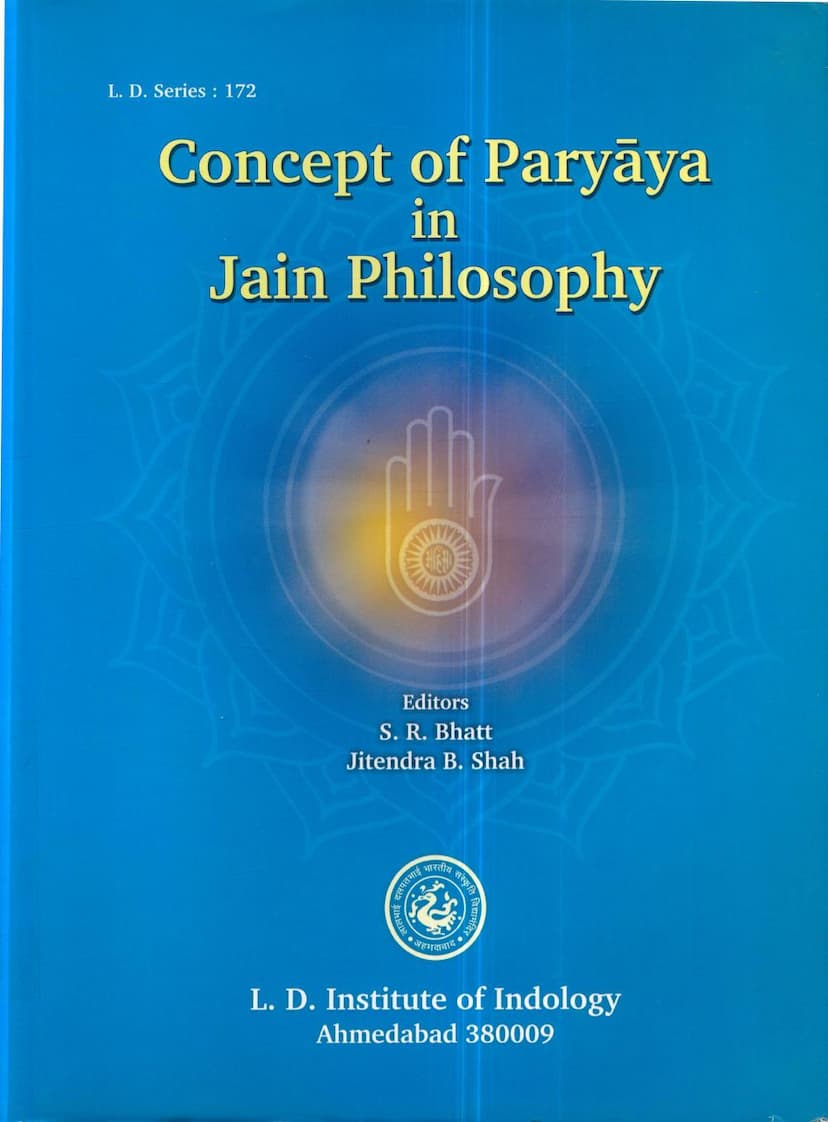Concept Of Paryaya In Jain Philosophy
Added to library: September 1, 2025

Summary
Here's a comprehensive summary of the Jain text "Concept of Paryaya in Jain Philosophy" by S. R. Bhatt and Jitendra B. Shah, based on the provided pages:
Overall Theme:
The book "Concept of Paryaya in Jain Philosophy" explores the profound and foundational concept of Paryaya (mode, modification, or manifestation) within Jain metaphysics, ethics, logic, and epistemology. It highlights Paryaya as a singular and unique contribution of Jainism to world philosophy, offering a nuanced understanding of reality that avoids absolutism and dogmatism. The book argues that this concept has wide-reaching implications across various fields, including science, mathematics, and daily life.
Key Concepts and Contributions:
-
Dravya, Guna, and Paryaya: The core of Jain metaphysics is built around the interrelationship of Dravya (substance), Guna (attribute), and Paryaya (mode/modification).
- Dravya: Represents the fundamental reality or substance that is eternal and unchanging in its essential nature (dravyavya). It persists through time and change.
- Guna: These are the essential, permanent attributes that constitute the very nature of a Dravya. They are inalienable and co-exist with the substance. Examples include consciousness in the soul.
- Paryaya: These are the transient modes, modifications, or manifestations of a Dravya and its Gunas. They arise and cease moment by moment, representing the changing aspects of reality. Paryaya is the conditioned mode of existence of substance and attributes.
-
Paryaya as the Essence of Change: The concept of Paryaya is central to understanding change in Jain philosophy. Every Dravya is understood to be in a state of constant modification (parinama). This change is not a negation of the substance but rather a manifestation of its inherent dynamism.
- Svabhavika (Natural) vs. Vaibhavika (Extraneous) Paryaya: Changes can be innate and subtle (like waves in the ocean) or externally induced.
- Artha-Paryaya (Implicit/Subtle) vs. Vyanjana-Paryaya (Explicit/Gross): Subtle modes are imperceptible to senses, while gross modes are perceptible.
-
Reconciliation of Permanence and Change: Jainism's unique contribution lies in its ability to reconcile the seemingly contradictory aspects of permanence (dhrauvya) and change (utpada-vyaya). Reality (Sat) is defined as that which possesses all three: origination, cessation, and persistence.
- This dual nature prevents Jainism from falling into either the absolutism of permanence (like some Vedanta schools) or the extreme flux of impermanence (like some Buddhist schools). Jainism posits that both are real and equally important.
-
Foundation for Anekantavada and Syadvada: The concept of Paryaya is intrinsically linked to Anekantavada (non-absolutism or manifoldness of reality) and Syadvada (relativism or conditional predication).
- Since every reality exists in multiple modes at different times and places, understanding a thing requires acknowledging its various Paryayas.
- Syadvada, with its seven-fold predication (Sapta-bhangi), explicitly incorporates this relativistic understanding, stating that judgments are conditioned by perspectives of substance, place, time, and state.
-
Implications for Ethics and Spirituality:
- Ethical Transformation: Understanding Paryaya reveals that an individual's current state (e.g., bondage, suffering) is not permanent. By understanding and cultivating svabhava (natural) Paryayas (pure modes) and abandoning vibhava (unnatural/impure) Paryayas (like attachment, aversion, passions), one can achieve spiritual transformation and liberation.
- Self-Realization: The concept emphasizes personal responsibility and the potential for self-evolution. Liberation (Moksa) is the ultimate Paryaya of the soul, where its innate pure consciousness is fully manifested.
- Ahimsā and Coexistence: The relativistic and non-absolutistic perspective fostered by Paryaya leads to mutual understanding, cooperation, and a foundation for Ahimsa (non-violence).
-
Implications for Science and Mathematics:
- Causality and Probability: The concept of change and modes provides a basis for understanding causality and even probabilistic thinking, as acknowledged by figures like Prof. Mahalnobis and Prof. J. B. S. Haldane.
- Mathematical Models: Jain texts contain sophisticated mathematical concepts that can be applied to understand the operation of karma, infinities, and set theory, potentially leading to "Copernican revolutions" in natural and social sciences.
- Material Significance: The constant flux and change inherent in Paryaya make the world dynamic and life meaningful. It also encourages adaptability and understanding in human interactions.
-
Critique of Other Philosophies: The book analyzes how Jainism's view of Paryaya differs from and potentially resolves issues found in other philosophical systems like Buddhism (pure flux) and Vedanta (absolute permanence). Jainism offers a balanced synthesis.
-
Kundakunda's Contribution: The work of Acharya Kundakunda is highlighted for his detailed exposition of Paryayas, particularly the distinction between svabhava (natural) and vibhava (unnatural) modes of the soul, and their ethico-spiritual implications.
Structure of the Book:
The book is a collection of scholarly papers, with an Introduction by S. R. Bhatt, followed by contributions from various scholars (Acharya Mahaprajna, Samani Chaitany Pragya, Dayanand Bhargava, Kokila H. Shah, Priya Jain, Pradumna Shah, Jagdish Prasad Jain "Sadhak", Rajjan Kumar, Rashmibhai Zaveri, Bijayananda Kar, Shugan C. Jain, Kamal Chand Sogani, Lopamudra Bhattacharyya) covering different facets of the Paryaya concept. The Publisher's Note clarifies that this English volume complements a previously published Hindi volume on the same topic.
Conclusion:
The "Concept of Paryaya in Jain Philosophy" presents Paryaya not just as a philosophical term but as a fundamental principle that underpins the Jain worldview. It offers a holistic understanding of reality that is both dynamic and enduring, providing a framework for ethical living, spiritual progress, and a nuanced understanding of the universe. The book emphasizes the need for further interdisciplinary research to fully explore the implications of this rich concept.